For the latest on Hoka Mafate trail shoes, check out our Hoka Mafate Speed 4 review.
Our Favorite Trail Running Shoes
Check out our Best Trail Running Shoes buyer’s guide to learn about our current favorite trail running shoes!
Hoka One One EVO Mafate Review
During the 2017 UTMB, I noticed that several Hoka One One-sponsored runners (Tim Tollefson and Jim Walmsley) were debuting a new model. Of course, this piqued my interest as a course like UTMB really throws everything at a runner in 100 miles. I was also confused by the name of the shoe as the original Mafate model was very heavy, and very maximal. This was followed by the equally heavy Mafate Speed, and both of these models had spent years in retirement. So, to clarify, the Hoka One One EVO Mafate ($170) is a 9.6-ounce, 4mm drop trail running shoe really designed to take on all surfaces. We all recognize this shoe now as the shoe that won, and set the record, at the 2018 Western States 100.
Fellow gear editor Travis Liles and I both put the Evo Mafate through the paces during our summer ultramarathon training and long mountain adventures. We agreed on both the shoe’s strengths, and a few of its shortcomings. What follows are our combined thoughts on the model.
 The Hoka One One Evo Mafate. All photos by iRunFar/Bryon Powell unless otherwise noted.
The Hoka One One Evo Mafate. All photos by iRunFar/Bryon Powell unless otherwise noted.Hoka One One Evo Mafate Upper
Hoka does something completely different with this upper in employing their MATRYX technology, using strategically placed Kevlar to increase durability, lock down, and drainage. This certainly does feel like an airy mesh and I appreciated how quickly the Evo Mafate’s upper drained after creek crossings. While the MATRYX Kevlar provides durability, it did become well creased, and a bit coarse, after repeated use and grime. Both of us noticed a pronounced and static crease across the metatarsal area of the foot which produced some irritation on the medial side of the big toe. For Travis, this meant irritation and blistering, and for myself it meant the formation of a large callous which eventually developed some maceration underneath. Either way, despite the wider nature of the Evo Mafate, the toebox continues to be heavily tapered.
Now, before I take on a deluge of defensive feedback, let’s be clear about the toebox width here. While it certainly is of medium width, it tapers in on the medial side of the foot, forcing the big toe over a bit. This tapering, combined with a bit of a cambered midsole on the inside of the shoe, caused me some irritation in runs over 20 miles in length. This combination had me more than ready to get the Evo Mafate off of my feet after 32 mountain miles. However, Travis was able to wear the this shoe for 12 hours of highly technical mountain trail with minimal issues. I do feel like the Kevlar-laden fabric is a bit rougher than most other uppers, but it’s really durable. In comparison, the Speedgoat 2 has a more highly tapered toebox, but the upper material is softer and more flexible which didn’t seem to put as much pressure on my big toe.
I did try to mitigate some of the toebox issues using a shoe stretcher which is commonly used for men’s leather dress shoes. This process allowed me to further stretch the medial upper of the Evo Mafate to accommodate my feet, and this is a recommended treatment for any runner wanting to customize fit.
The rest of the upper functions fairly well. Some runners may be a bit annoyed by the higher-than-normal heel collar, and I did experience some rubbing from the heel collar when wearing very short ‘no-show’ socks. Longer running socks completely mitigated the issue. However, the tongue of the Evo Mafate is an area of concern. The tongue is perforated and thin which both moved around and allowed a lot of dust and debris into the shoe. A gusseted tongue would really be appreciated in this shoe.
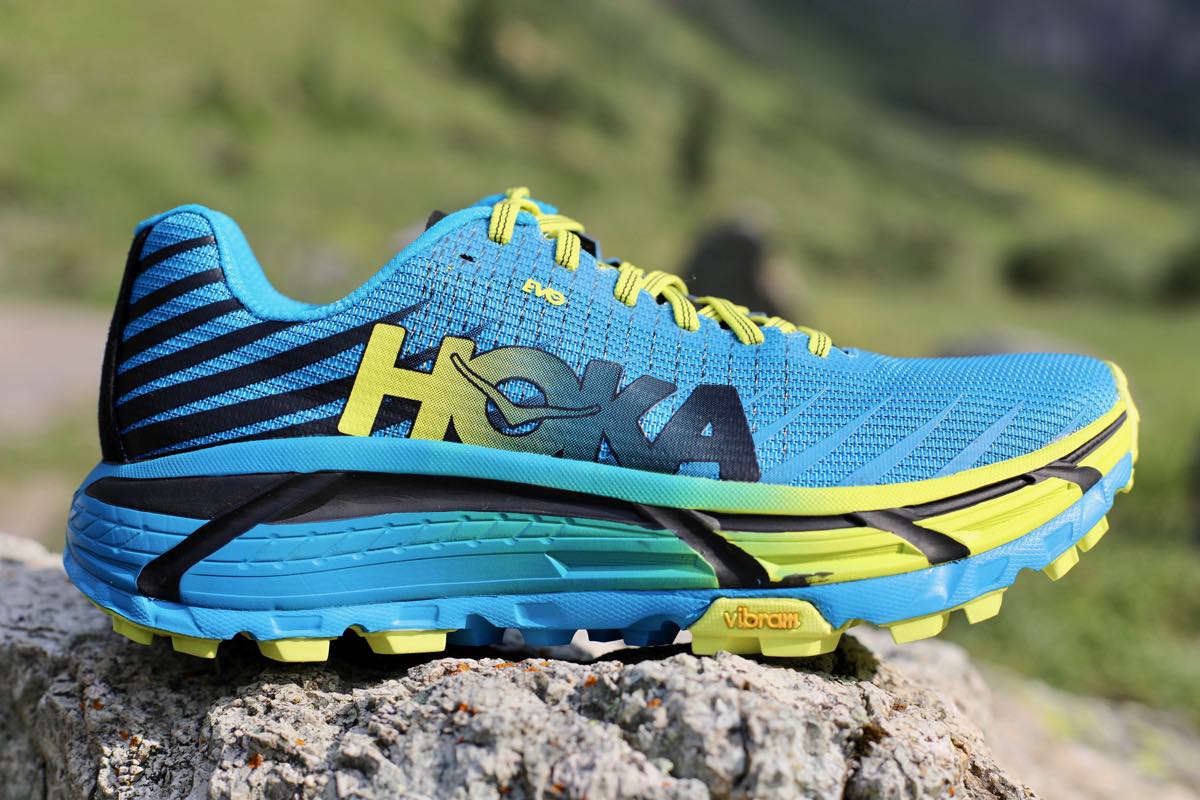 The Hoka One One Evo Mafate lateral upper.
The Hoka One One Evo Mafate lateral upper.Hoka One One Evo Mafate Midsole
Overall, Hoka has managed to create a midsole that feels fast and relatively stable for a shoe with 34mm stack height in the heel and 30mm in the forefoot. The feel is a bit less squishy than a typical Hoka, and noticeably firmer than the Speedgoat 2. This caused the Evo Mafate to feel a bit more stable on really technical sections of trail, such as picking your way across talus and off-camber trail. Hoka uses their EVA top layer for a nice, soft feel on top of a firmer-durometer R-BOUND midsole which is firmer and lighter weight. This combination is really the best combo of Hoka cushioning I’ve experienced for a trail shoe, and the Evo Mafate excelled on surfaces where I felt the Speedgoat 2 was too soft. Specifically, sandy or muddy trails that seem to suck the life out of a shoe.
Travis and I are both sitting at around 150 miles in this shoe, and we are seeing resilience in the midsole that does not lead me to believe it will feel dead any time soon. Hoka’s early-stage Meta-Rocker technology is in full effect on the Evo Mafate, and the transition of this shoe is very smooth at fast paces.
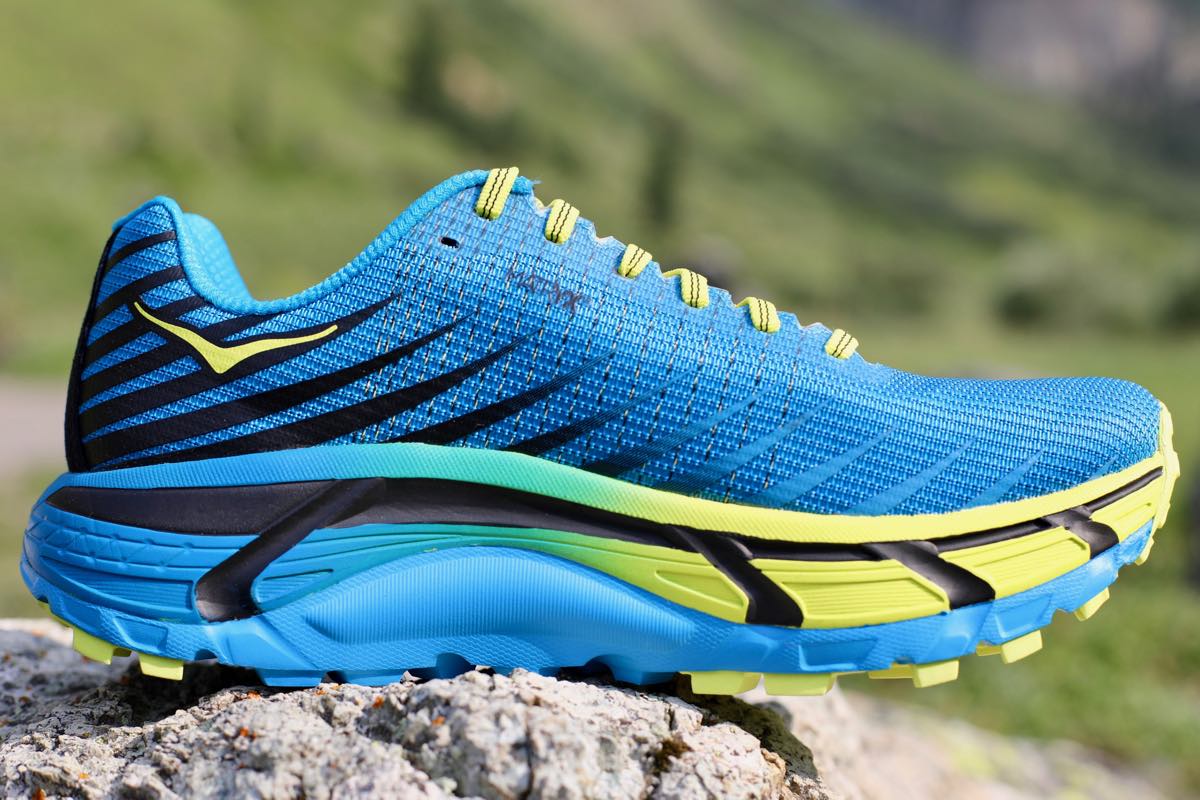 The Hoka One One Evo Mafate medial upper.
The Hoka One One Evo Mafate medial upper.Hoka One One Evo Mafate Outsole
Hoka uses Vibram’s MegaGrip outsole which does a great job over a variety of surfaces, wet and dry. I didn’t notice a performance difference between the MegraGrip outsole on the Evo Mafate and the Speedgoat 2. This outsole rubber seemed like a great all-arounder and I didn’t find myself sliding around on loose, marble-y decomposed granite on technical downhills in my part of Colorado, or wet rock around drainages. The Evo Mafate does pick up some small pebbles in the outsole, specifically where the drainage holes are located, but this doesn’t affect function or add much weight. I don’t see this outsole rubber wearing down quickly, and a rock plate is not needed due to the model’s high stack height.
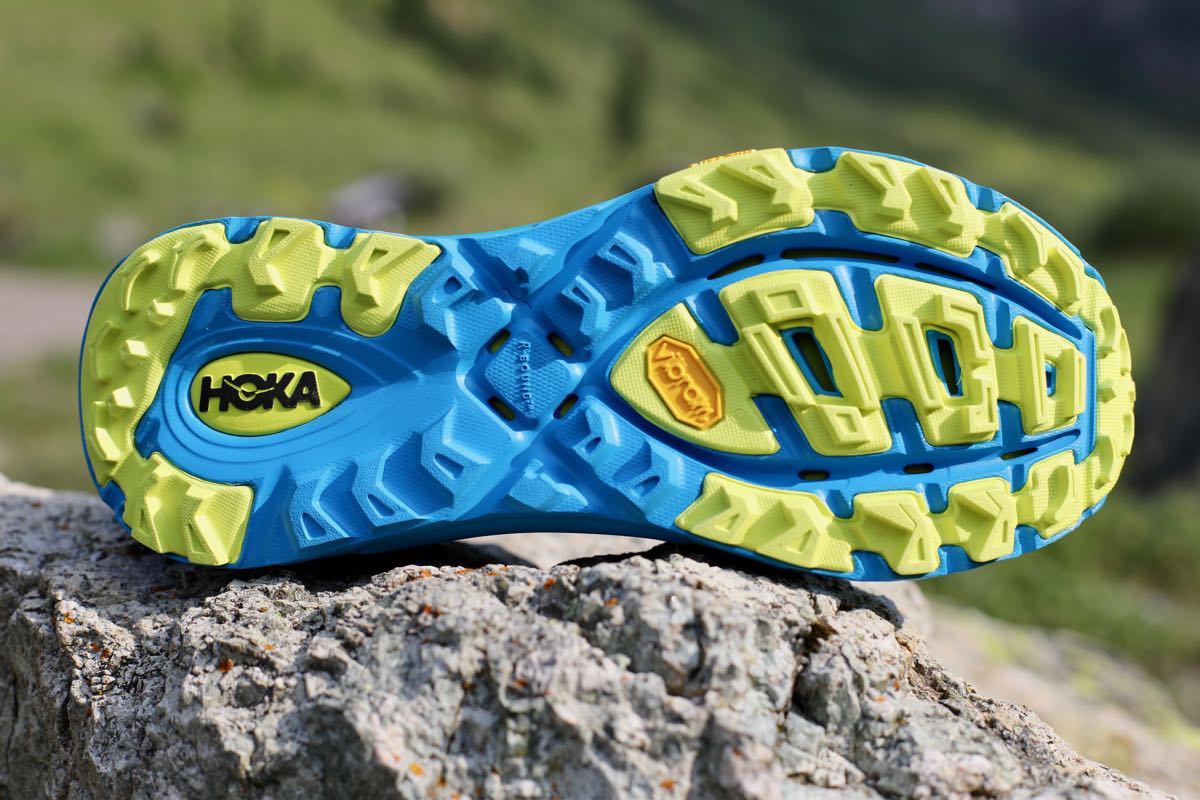 The Hoka One One Evo Mafate outsole.
The Hoka One One Evo Mafate outsole.Hoka One One Evo Mafate Overall Impressions
The Evo Mafate is a surprisingly stable and resilient, maximally cushioned shoe that never feels sloppy or labored on the foot. The firmness of the midsole does favor faster paces on both smooth trail and technical surfaces. The locked-down fit throughout the midfoot and forefoot inspire a lot of confidence on technical downhills and no sliding forward was experienced. This is the type of trail shoe that could be worn for 50k to 100 miles on really any type of terrain besides road. (The Vibram outsole is a bit too much to make this a hybrid shoe.)
Both Travis and I have very limited complaints about the shoe, and perhaps small changes to the tongue and softening of the upper would perfect this model. Either way, the Evo Mafate certainly has a permanent place in Hoka’s arsenal with a distinctly different feel from the Speedgoat 2 and beefier models in the line-up. The question is, as always: is this shoe worth its $170 price tag? For $30 more than the Speedgoat 2, runners needing a slightly wider fit will find the Evo Mafate more accommodating and more durable. Still, runners needing a truly wide shoe will have to look elsewhere as the Evo Mafate is yet to come in widths. Ultimately, this is another very solid release from Hoka and a shoe that most runners will enjoy a great deal and find to be a solid investment for their next ultramarathon.
Call for Comments (from Meghan)
- Have you run in the Hoka One One Evo Mafate? What do you think of the shoe overall? And, can you talk about some of the details of the shoe that you’ve noticed?
- What are your thoughts on the Evo Mafate’s upper and how it behaves on your foot?
- What do you think of the two-compound midsole and its feel on the trails upon which you run?
[Editor’s Note: If you’re affiliated (i.e., an employee, ambassador, etc.) with a shoe brand, please share your relation in each of your comments on this article. Thanks!]
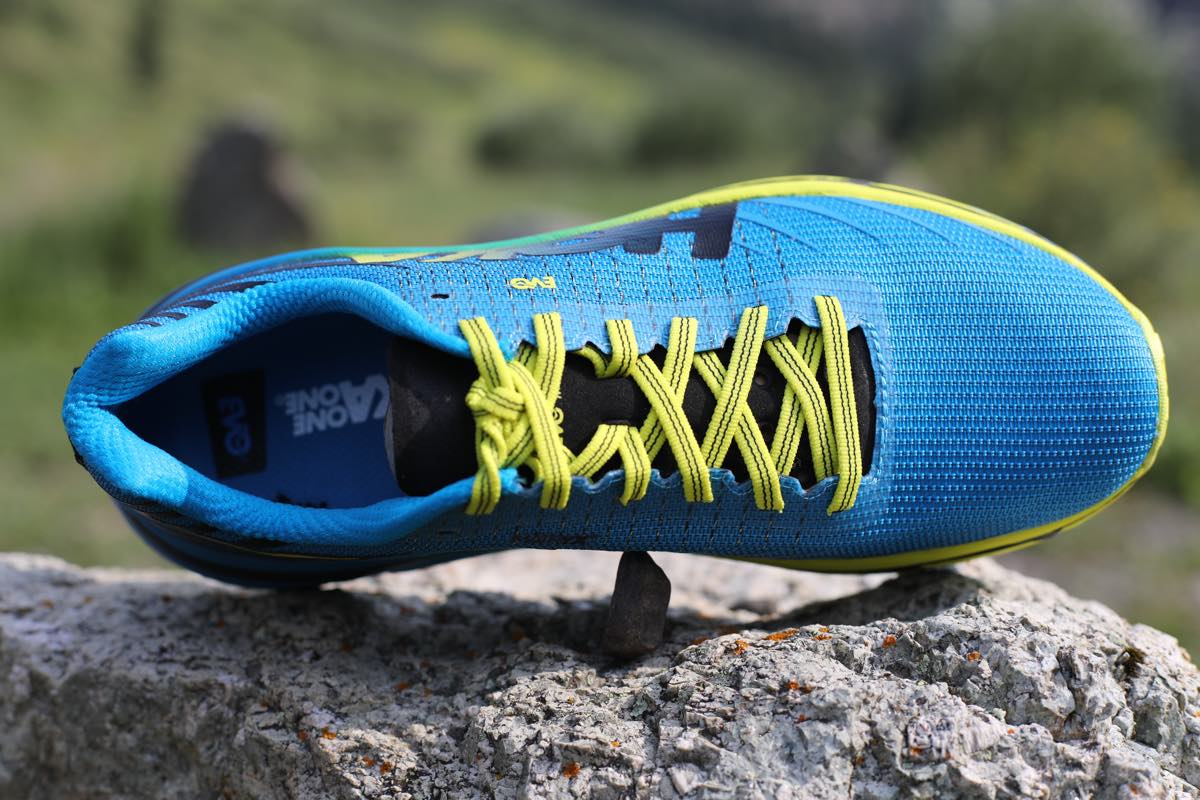 The Hoka One One Evo Mafate view from the top.
The Hoka One One Evo Mafate view from the top.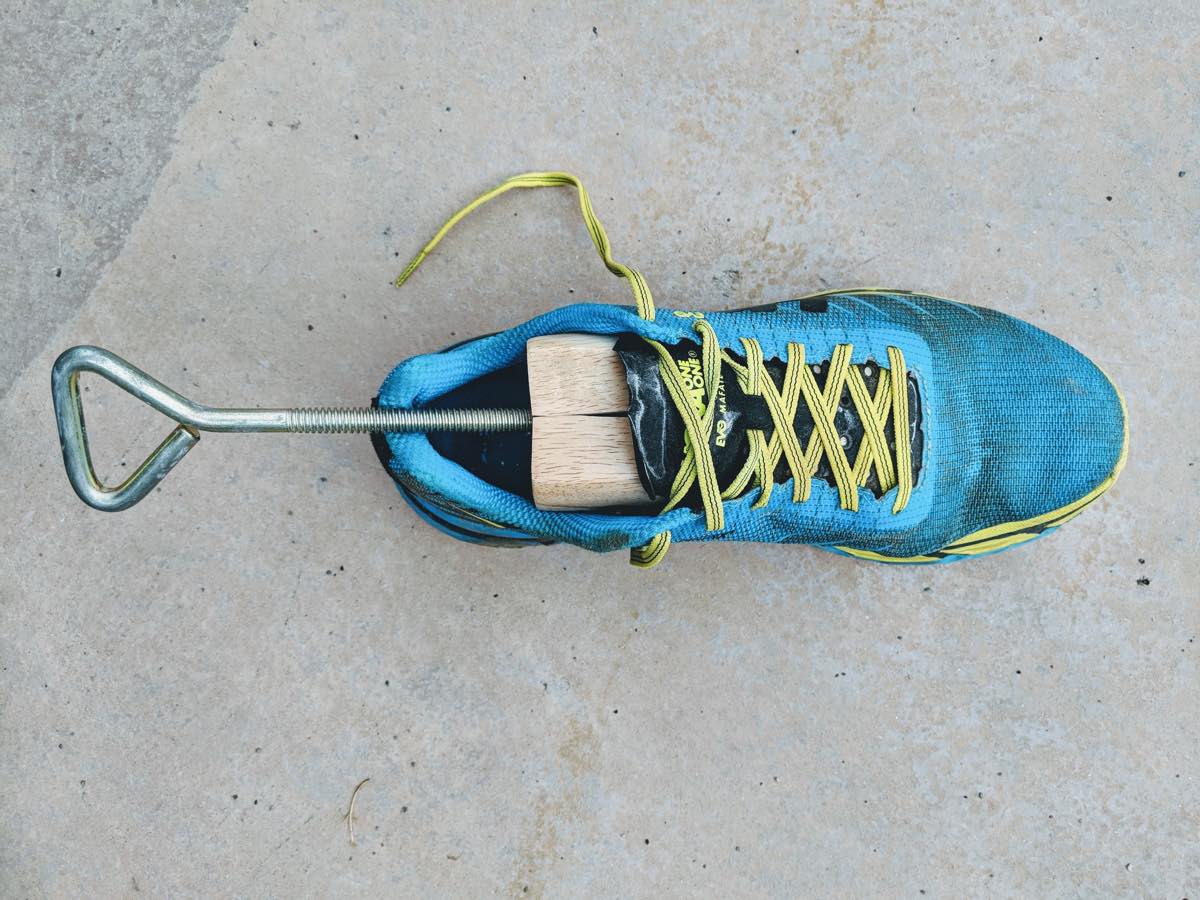 Photo shows how the author stretched the Evo Mafate’s upper using a shoe stretcher. Photo: iRunFar/Tom Caughlan
Photo shows how the author stretched the Evo Mafate’s upper using a shoe stretcher. Photo: iRunFar/Tom Caughlan